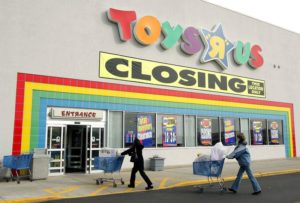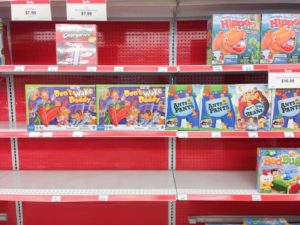Building and fostering an authentic brand relationship with consumers has been a running theme throughout our course materials this semester. Not only have Heath & Heath (2007), Young (2014), and Vaynerchuck (2013) all discussed the importance of connecting with consumers, but it has also been a central tenet found throughout Brandon Rochon’s remarks. In light of this prevailing concept, I figured it would be both informative and thought-provoking to present a cautionary tale of a company that did everything wrong in terms of consumer relationship building and clearly did not pay any attention to any of the literature about successful advertising. Nearly 40 years after going public, Toys  R Us recently announced plans to liquidate, a move that signals the ultimate demise of a company that once cornered the market on toy sales (Hirsch, 2018). In its prime, Toys R Us was essentially heaven for children of all ages, the preeminent destination for all toys from Lego sets to race cars to video games (Hirsch, 2018). Much of the company’s success was built on the fact it forged strong brand loyalty with a targeted audience—parents who wanted to make their children happy. This strategy worked for most of the 1980s and 1990s, however, a string of ownership changes combined with institutional arrogance led to a fractured relationship between the company and its top demographic (Hirsch, 2018).
R Us recently announced plans to liquidate, a move that signals the ultimate demise of a company that once cornered the market on toy sales (Hirsch, 2018). In its prime, Toys R Us was essentially heaven for children of all ages, the preeminent destination for all toys from Lego sets to race cars to video games (Hirsch, 2018). Much of the company’s success was built on the fact it forged strong brand loyalty with a targeted audience—parents who wanted to make their children happy. This strategy worked for most of the 1980s and 1990s, however, a string of ownership changes combined with institutional arrogance led to a fractured relationship between the company and its top demographic (Hirsch, 2018).
Apparently, many key decision makers felt that Toys R Us would always maintain its spot as leader in the toy industry and as a result, never felt the urge to evolve by keeping up  with consumer trends, investing in stores that were financially successful, and reallocating resources in those that were not performing as well (Hirsch, 2018). This lack of engagement also manifested itself in the form of actual physical deterioration since Toys R Us ignored opportunities to either renovate its stores or make them look cleaner. Perhaps the company’s most damning mistake is that it never adapted to changing technologies. In the late 1990s, online merchants like Amazon and EToys started popping up in the market and not only threatened Toys R Us’ prime positioning, but supplanted the company as a sales leader. By the time Toys R Us tried to move online, it was already too late and the company had wasted millions of dollars trying to secure exclusive merchandising rights with Amazon.
with consumer trends, investing in stores that were financially successful, and reallocating resources in those that were not performing as well (Hirsch, 2018). This lack of engagement also manifested itself in the form of actual physical deterioration since Toys R Us ignored opportunities to either renovate its stores or make them look cleaner. Perhaps the company’s most damning mistake is that it never adapted to changing technologies. In the late 1990s, online merchants like Amazon and EToys started popping up in the market and not only threatened Toys R Us’ prime positioning, but supplanted the company as a sales leader. By the time Toys R Us tried to move online, it was already too late and the company had wasted millions of dollars trying to secure exclusive merchandising rights with Amazon.
Ultimately, this is a picture-perfect example of a company that never grew in its brand cycle and its evolution came to a screeching halt (Hollingshead, 2018). Rather than taking inventory on how its brand is perceived and focusing on new ways to either strengthen orreinvent its relationship with consumers, the company neglected its customers and by the time it realized there was a problem, it lost its place in the industry (Hollingshead, 2018; Heath & Heath, 2007). It is so appropriate that many of our materials compare the consumer-business dynamic to personal relationships because in this instance Toys R Us is the husband that let himself go, stopped buying flowers, and thinking of creative romantic dates. Then, 10 years later, he has no clue why his wife files for divorce. Unfortunately, it does not look like Toys R Us will have a chance to win back its consumers.
References
Heath, C. & Heath, D. (2007). Made to stick: Why some ideas survive and others die [Kindle version]. Retrieved from Amazon.com
Hirsch, L. (2018, March 16). Toys R Us built a kingdom and the world’s biggest toy store. Then, they lost it. CNBC. Retrieved from https://www.cnbc.com/2019/01/26/toys-r-us-built-a-kingdom-and-the-worlds-biggest-toy-store-then-they-lost-it.html
Hollingshead, A. (2018). The 6 M’s of IMC plans [PowerPoint slides]. Retrieved from https://lmscontent.embanet.com/USC/CMGT541/CMGT541_w07_alt.pdf
Vaynerchuck, G. (2013). Jab, jab, jab, right hook: How to tell your story in a noisy social world [Kindle version]. Retrieved from Amazon.com
Young, A. (2014). Brand media strategy: Integrated communications planning in the digital era. New York: Palgrave Macmillan.

7 Responses to Out of Business R Us: The collapse of a global toy store empire